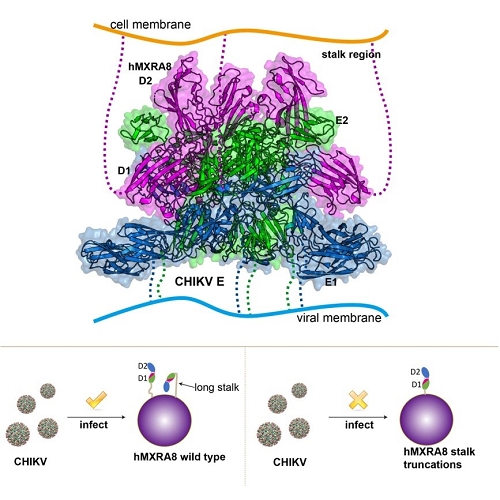
Recently, George F. Gao and GAO Feng from the Chinese Academy of Sciences and the collaborators revealed how Chikungunya virus binds its receptor on human cells through structural biology and virology methods. The study was published in Cell.
Arthritogenic alphaviruses, such as Chikungunya virus (CHIKV), Ross River virus (RRV), Mayaro virus (MAYV), and O’nyong-nyong virus (ONNV), cause severe and debilitating rheumatic diseases. Alphaviral invasions of susceptible cells are mediated by the envelope (E) glycoproteins, which form icosahedral shells at the virion surfaces.
CHIKV is a serious disease in many tropical and subtropical countries. CHIKV infection is characterized by acute and chronic symmetrical peripheral polyarthralgia-polyarthritis. Like other alphaviruses, CHIKV entry is mediated by two glycoproteins, E1 and E2, on the surface of the virion. It is believed that the glycoprotein E2 is responsible for receptor binding, while E1 is responsible for membrane fusion.
In this study, researchers showed that multiple emerging arthritogenic alphaviruses, including CHIKV, RRV, MAYV, and ONNV, use matrix remodeling-associated protein 8 (MXRA8) as a functional receptor. How this receptor binds the envelope protein is the key question to be addressed, which will be helpful for the development of countermeasures against these viruses and the understanding of the viral entry into the cells.
Researches first solved the crystal structures of the mouse MXRA8, human MXRA8 in complex with the CHIKV E protein, and the cryo-electron microscopy structure of human MXRA8 and CHIKV virus-like particle. They found that MXRA8 has two Ig-like domains that display unique structural topologies, different from those of the previously described two-domain Ig-like molecules.
Domain 1 (D1) is formed by two discrete fragments, while the region between these two fragments consists of the hinge region and domain 2 (D2), that is, the linear protein sequence crosses the two domains. Therefore, the two Ig-like domains are connected by two hinge loops.
Besides, they found that the binding mode of MXRA8 to CHIKV E is unique. MXRA8 binds in the “canyon” between two protomers of the E spike on the virion surface, with the involvement of both the E1 and the E2 proteins. The atomic details of the interface between the two binding entities revealed that the two domains and the MXRA8 hinge region all interact with the CHIKV E1-E2 residues from two protomers.
The critical interactions observed in the complex structure were further demonstrated by site-directed alanine-scanning mutagenesis and surface plasmon resonance (SPR) experiments.
In addition, researchers showed that the stalk region of MXRA8 was necessary for efficient binding and entry.
The identification of multiple binding interfaces for receptor-envelope interaction might inform the development of novel vaccines and broadly neutralizing antibodies. The study will help to drive the development of powerful antiviral reagents against arthritogenic alphaviruses.

Figure: The mechanism of CHIKV entry mediated by MXRA8 receptor

86-10-68597521 (day)
86-10-68597289 (night)

52 Sanlihe Rd., Xicheng District,
Beijing, China (100864)

